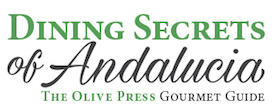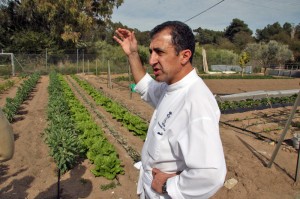By author Jon Clarke
THE food revolution that has made Spain famous around the world has finally come south.
With a trio of the country’s restaurants in the world Top Ten according to Restaurant magazine – more even than France! – it was perhaps inevitable that Andalucia would finally catch up.
Not just geographically close to the cocina creativa heartland of the Basque region and Catalonia, Andalucia is where many of Spain’s best ingredients come from.
The Moors described the region as ‘a paradise’ on conquering al-Andalus in the 8th century. And their legacy still lives on today in the water courses (acequias) they dug and the terraces they carved out to best utilise water.
There is little doubt, as long as it keeps raining (and that is touch and go after four years of drought) you can grow and rear almost anything in Andalucia.
From avocados to artichokes and from custard apples to oranges, the quality of ingredients is second to none; a fact reflected in the huge percentage of produce in northern European supermarkets that comes from Andalucia.
But what most outsiders also forget is that the best ham in the world – the celebrated Jamon Iberico – comes from Andalucia, in Aracena. And arguable some of Spain’s best cheeses come from the region; the goats cheeses of Ronda, for example, are served up in some of Madrid’s finest restaurants.
In Laurie Lee’s seminal book on Spain ‘As I Walked Out One Midsummer Morning’, he waxed lyrical about the ham as he crossed the rugged Sierra Morena mountains from Castile into Andalucia.
Then, of course, is the wine, with the sherries of the Jerez region among the world’s best fortified wines. And on top of that are the delightful sweet wines (the moscatels and pedro ximenez’s) of Malaga, with Granada, and in particular, Ronda’s wines fast achieving an excellent reputation too.
As a journalist and travel writer covering the region for the UK national newspapers and more recently my own Andalucian newspaper the Olive Press (www.theolivepress.es) I have been staggered by the changes over the last five years.
While I used to struggle to find a dozen good restaurants in the whole region, there is now somewhere good to eat in almost every town. Even some of the most remote, obscure villages – places largely untouched by tourism such as Algarinejo and Galaroza – have top class eateries.
The change has been so fast that the mainstream guides, such as Michelin or Gourmetour, have quite simply struggled to keep up. With difficult remits and not enough inspectors they are finding it hard to winkle out the new hidden gems.
It is for this reason that I decided to launch this guide, a nearly two-year trawl of the locally-recommended restaurants that shouted out for a visit.
Trying to get an even spread across the whole region proved hard, with the bulk of restaurants in Malaga province reflecting where the bulk of tourists flock. A simple matter of demand.
But, wherever I headed, be it to Aracena, Jaen, or to the remote Cabo de Gata region of Almeria, I was constantly surprised at the wonderful new places opening up.
Most encouraging of all is that the region is evolving its own distinct style of cooking. Not content to simply copy styles from up north, most of the region’s chefs have remained defiantly Andaluz, using local ingredients and adapting and building on classic local dishes such as ajo blanco, porra and rabo de toro.
Indeed, in some of the best restaurants practically every dish was from Andalucia.
As chef Richard Alcayde at Med in Torremolinos explained: “Things are changing so fast in Andalucia. Of course we have all learnt a lot from Ferran Adria and Arzak, in Bilbao, but now we are developing our very own style. Confidence is high and in Andalucia we have everything we need to have the best restaurants in the world.”
Going mostly on the quality of food, the guide was always however looking out for those places that had a certain je ne sais quoi? Whether this was for their ambience, great alfesco dining or brilliant wines we gave them a go. Above all, it was not all about fine food and haute cuisine, and a number of cheap local ventas, as they are called, make it into the book.
A number of places had great potential, or didn’t quite fit the mould this time. We have listed many of those in our Wildcard section.
But sadly all is not well in Andalucia. The paradise that remained intact until the 1970s has come remarkably close to being ruined. If not by endless tower blocks and water-thirsty golf courses, then by the creeping spread of plasticulture, to provide northern Europe with early Spring vegetables.
Leeching the soil of its nutrients, not to mention create an awful eyesore, the trend to grow in huge plastic greenhouses has already covered most of the Almeria coastline and is making huge inroads into Granada and Malaga.
Golf courses are, of course, merely used now as an excuse to build more housing. They are depriving this once fecund land of its lifeblood; water. There are already 150 built in Andalucia (the highest concentration in Europe) with a similar number projected. Some parts of the region have been completely turned over to golf, with the coastal area of La Cala de Mijas counting some six courses in total.
Enough is enough. Golf courses simply do not create enough jobs and rob the region of its best agricultural land, not to mention water in one of the driest parts of Europe, after – as I write – officially four years of drought.
Yet, all is not lost. Slowly the Andalucians are beginning to understand how fragile their ecosystem is. New laws have been introduced to protect the countryside, and many golf projects are currently frozen. The downturn in the economy has certainly helped to push an army of developers into the buffers.
Many restaurateurs understand the urgency to protect what is left. They rely on getting the fine ingredients that are the make or break factor to their success.
When one American chef took over a restaurant in Cadiz province a few years ago, he was shocked to discover that the lettuces were kept under the grill, while the vegetables were stored in the freezer.
No longer can good restaurants expect to get away with that. In Ronda, for example, there are around half a dozen highly-rated restaurants competing with each other. And each would sink without trace if their ingredients stopped being anything but tip top fresh.
But around Andalucia now, chefs are having to battle to get the ingredients the customer is now demanding. They now accept that green vegetables, and salads – with more than just tinned asparagus and sweetcorn – are the norm.
As one chef in Granada explained, people now expect to have at least one good pate or foie gras on the menu, when five years ago, they would never have touched it.
Another restauranteur takes a two-hour journey practically every day to personally select his fish from Cadiz, while others have their own vegetable gardens.
At El Faro in El Puerto de Santa Maria, chef Fernando Cordoba is so enthusiastic about his prize artichokes he insisted on taking me on a personal tour of his wonderful vegetable garden, that at various times of the year provides up to half his ingredients.
Nearby at Aponiente, easily Spain’s best fish restaurant, genius Angel Leon discovered that the only way to land the unfashionable, unendangered fish he wanted – having stopped buying tuna and cod – was to lease his own fishing boat.
Also exciting is the huge growth of the organic sector. There are now thousands of organic producers across the region, who understand the importance of pesticide-free fruit and vegetables. But sadly, more than 80 per cent of this is currently exported.
Most positive of all though is where it all begins. No doubt a surprise to many, but a cookery school, not only made this book, but is one of its best enteries.
Installed in an Italianate villa, where Ernest Hemingway and David Niven once stayed, today La Consula is a true dining secret.
The sort of place to spot the regional politicians or actor Antonio Banderas on his regular trips back to his native Malaga, few places tick so many boxes.
The attention to detail and professionalism is remarkable given that everyone from the receptionist to the waiters are learning their trade .
But, the best thing about La Consula, is the food, and it is no surprise that half of the region’s best chefs – a number of them Michelin-starred – started their careers here.
As Dani Garcia, Andalucia’s most famous chef told me: “It all begins at La Consula. It is the lifeblood of Andalucian cuisine.”
With one of the basics in place, like this, the future for Andalucian cuisine could not be brighter.

